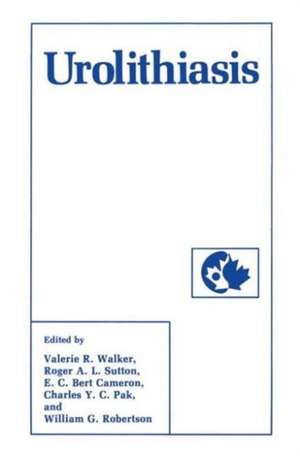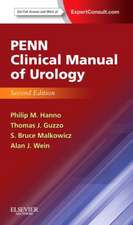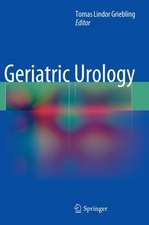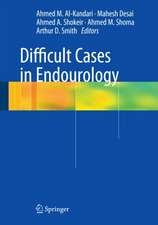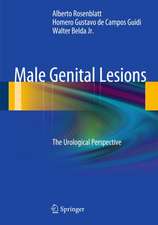Urolithiasis
Editat de Valerie R. Walker, Roger A. L. Sutton, E. C. Bert Cameronen Limba Engleză Hardback – 30 sep 1989
| Toate formatele și edițiile | Preț | Express |
|---|---|---|
| Paperback (1) | 2147.92 lei 6-8 săpt. | |
| Springer Us – 15 aug 2013 | 2147.92 lei 6-8 săpt. | |
| Hardback (1) | 2036.14 lei 39-44 zile | |
| Springer Us – 30 sep 1989 | 2036.14 lei 39-44 zile |
Preț: 2036.14 lei
Preț vechi: 2143.30 lei
-5% Nou
Puncte Express: 3054
Preț estimativ în valută:
389.63€ • 416.63$ • 324.85£
389.63€ • 416.63$ • 324.85£
Carte tipărită la comandă
Livrare economică 14-19 aprilie
Preluare comenzi: 021 569.72.76
Specificații
ISBN-13: 9780306432491
ISBN-10: 0306432498
Pagini: 1066
Ilustrații: XXXV, 1066 p.
Greutate: 0 kg
Ediția:1989
Editura: Springer Us
Colecția Springer
Locul publicării:New York, NY, United States
ISBN-10: 0306432498
Pagini: 1066
Ilustrații: XXXV, 1066 p.
Greutate: 0 kg
Ediția:1989
Editura: Springer Us
Colecția Springer
Locul publicării:New York, NY, United States
Public țintă
ResearchDescriere
This volume comprises the proceedings of the sixth in a series of International Symposia devoted to basic and clinical aspects of urolithiasis. Previous symposia have been held at intervals of four years in Leeds, Madrid, Davos, Williamsburg, and Garmisch-Partenkirchen. The sixth symposium was held in Vancouver, British Columbia and was attended by over 250 participants from 26 countries around the world. As may be seen from the contents of this volume, the meeting covered many aspects of urolithiasis including the underlying physiology, crystal formation and the effects of inhibitors and promoters on crystallization, endocrinology and abnormalities of urinary composition, analyses, geography and epidemiology, and medical and surgical treatment with a special emphasis on extracorporeal lithotripsy. Internationally-recognized authorities gave invited talks in each of these areas, and from the submitted abstracts 30 were selected for oral presentation and the remainder were presented in either general or theme poster sessions. The nine theme-poster sessions provided a particularly valuable and successful feature of the meeting, giving an opportunity for a group of researchers working in related areas to present their posters and also to give a brief oral summary which was followed by discussion with the audience. Each of these poster sessions was chaired by two experts in the field who have provided an overview of each theme-poster session for this volume.
Cuprins
Physiology and Urolithiasis.- Morphology of Renal Epithelium.- Renal Tubular Calcium Transport.- The Possibility of a Specific Calcium Sensor/Receptor Function of Proximal Renal Tubular Cells.- Physiology of Acid-Base Balance.- Intestinal Calcium Transport.- Crystalluria.- On the Occurrence and Nature of Crystals in Human Urine.- Histochemistry of Urinary Deposits.- Biochemistry of Crystalluric as Compared to Non-Crystalluric Stone Formers.- Microlith Formation in Urine: A New Evidence.- Matrix in Stone: An Electron Microscopy Study.- The Relative Merits of Early Morning vs Random Urine Samples for Studying Crystalluria.- Effect of Temperature on Crystal Growth and Morphology.- Seasonal Variations in Urinary Crystalluria and Glutamate Transaminase Levels in Stone Formers and Healthy Normal Subjects.- Kinetic Quantification of Crystal Growth in Gel Matrices: An Efficient Model of Urinary Stone Formation.- Quantitative Studies of Calcium Crystalluria.- New Spectrophotometric Method for Measuring Calcium-Oxalate-Monohydrate Crystal Aggregation in the Absence of Supersaturation.- Gentamycin Accelerates Calcium-Oxalate-Monohydrate (COM) Nucleation.- Calcium-Oxalate Precipitation in a Flow System.- A Simple Method for Determining the Metastable Limit of Calcium Oxalate.- Investigations of the Crystallization Tendency in Urine with Frequency Response Analysis (Impedimetry) and Cyclic Voltametry.- The Effect of Urinary Macromolecules on the Crystal Growth of Calcium Oxalate in Gel.- Changes in the Behavior of Urinary Inhibitors in Calcium-Oxalate Urolithiasis.- Stone Formation in the Human Kidney.- Binding of Calcium Oxalate and Apatite Crystals to Renal Papillary Collecting Tubule Cells in Primary Culture.- Effect of Extract of Hirudo Medicinalis L. Against Adherences of Calcium Oxalate Crystals to Acid-Injured Bladder Mucosa.- Inhibitors and Promoters of Crystallization.- Mineralization Inhibitors and Promoters.- Small-Molecular-Weight Inhibitors.- Macromolecular Inhibitors.- Glycosaminoglycans as Inhibitors of Renal Stone Formation.- The Relationship Between Citrate and Calcium-Oxalate Crystal Agglomeration.- Promotive Effect of Urines from Patients with Primary Hyperparathyroidism on Calcium-Oxalate Crystal Aggregation.- Theme Poster Session: Inhibitors I.- Renal Proximal Tubular Injury and Crystallization of Calcium Oxalate in Rat Urine.- Membrane-Induced Calcium-Oxalate Crystal Nucleation.- Lipids of Calcium-Oxalate Urinary Stones.- Ultrafiltration Studies Demonstrate Effects of Urinary Macromolecules on Crystallization of Endogenous Calcium Oxalate in Urine.- The Effect of Macromolecules on the Crystallization of Calcium Oxalate in Human Urine.- Nephrocalcin Isolated from Human Kidney Stones is a Defective Calcium-Oxalate-Monohydrate Crystal-Aggregation Inhibitor.- Effective Prevention of Calcium-Oxalate Crystal Formation in vitro and in vivo by Pentosan Polysulfate.- The Effect of Uric Acid on the Inhibition of Hydroxyapatite Crystal Growth.- At Last, A Non-Iterative Program to Calculate Growth and Aggregation Rates!.- Assessment of Aggregation of Calcium-Containing Crystals.- Combined Influence of Urinary Calcium and Oxalate Concentrations on Crystal Formation in Stone Formers.- Calcium-Oxalate Crystal Formation in Urolithiasis.- Theme Poster Session: Inhibitors II.- What is Renal Stone Matrix?.- On the Role of the Organic Matrix in the Architecture of Urinary Stones.- Functional Heterogeneity of Tamm-Horsfall Glycoprotein Isolated from Urines of Normal Subjects and Idiopathic Calcium-Oxalate Stone Formers and from Human Calcium-Oxalate Kidney Stones.- The Effect of Tamm-Horsfall Mucoprotein on Calcium Oxalate Crystallization in Urine: Two Methods Compared.- Multiple Effects of Amino Acids and Tamm-Horsfall Glycoprotein on the Precipitation of Calcium Oxalate.- Polyanionic Inhibition Versus Supersaturation in Male and Female Recurrent Calcium-Stone Formers.- Nucleation and Growth Inhibitors of Calcium Oxalate Crystallization.- Calcium-Oxalate-Dihydrate Production.- The Inhibitory Effect of Sodium Pentosan Polysulfate on Calcium-Oxalate Crystal Formation in vitro and in vivo.- Suppression of Struvite and Newberyite Bladder-Stone Formation in Rats by Phosphocitrate.- 1H and 2H Nuclear Relaxation Studies of Lyophilized Urines.- Inhibitors of Heterogeneous Nucleation in Urolithiasis.- Do Stone Formers Lack Inhibitors in Urine?.- Deficit of Inhibitors and Renal Lithiasis.- Modulation of Calcium-Oxalate-Monohydrate Crystallization Kinetics in Vitro.- Urinary Excretion of Lithogenic Substances and Inhibitory Activity Towards Calcium-Oxalate-Monohydrate Crystal Growth in Idiopathic Urolithiasis.- The Effect of Urinary Constituents of Low Molecular Weight on the Crystal Growth of Calcium Oxalate in Gel.- Investigations of Formation and Dissolution of the Stone Minerals, Oxalate and Apatite.- Role of Pyrophosphate in Calculogenesis.- Magnesium Inhibits Octacalcium Phosphate and Apatite but Promotes Whitlockite and Brushite Formation.- Is Hypomagnesuria Frequent in Stone Formers?.- Trace-Element Contents of Serum, Urine, and Kidney Stones in Urinary Stone Formers.- Ability of Some Carboxylic and Phosphorylated Carboxylic Acids to Prevent Hydroxyapatite and Calcium-Oxalate Precipitation.- Urinary Macromolecular-Inhibitory-Substances of Calcium-Oxalate-Monohydrate Crystal Growth.- Glycosaminoglycans and Urolithiasis.- Adherence of Glycosaminoglycans to Calcium-Oxalate Crystals.- Seromucoids, Urinary Mucoproteins, Tamm-Horsfall Protein, Glycosaminoglycans, and Total Carbohydrates in Stone Disease.- Study of Circadian Rhythmicity of Urinary Excretion of Glycosaminoglycans in Normal Subjects and Stone Formers.- Favorable Effect of Glycosaminoglycans on Cellular and Urinary Abnormalities in Idiopathic Calcium-Oxalate Nephrolithiasis.- Decreased Erythrocyte Glycosaminoglycan Content in Idiopathic Calcium-Oxalate Nephrolithiasis.- Urinary Excretion of Glycosaminoglycans in Calcium Lithiasis: The Role of Protein Intake.- Correlation of Urinary Excretion of Glycosaminoglycans and Uric Acid in Healthy Adults and in Renal Stone Formers.- Calcium-Oxalate Crystal Growth: Influence of Natural Inhibitors.- Effect of Calcitriol Administration on Urinary Excretion of Nephrocalcin, A Calcium-Oxalate Crystal-Growth Inhibitor.- The Influence of Additives on Nucleation, Crystal Growth, and Aggregation of Calcium-Oxalate Hydrates.- Amino Acid Excretion in Urinary Calculous Disease.- The Effect of Glutamic Acid and Aspartic Acid on Calcium-Containing Stones.- Non-Calcium Stones.- Renal Infections and Stones.- Bacterial Ecology in Struvite Calculogenesis.- Urinary Calculi and Urinary Tract Infection.- Urinary Tract Infection and Urinary Stone Disease.- The Role of Infection in the Adherence of Urease-Induced Crystals to the Urothelium.- Ureaplasma Urealyticum: An Etiological Agent for the Development of Infection Stones in the Urinary Tract.- Renal Calculi and Bacterial Adherence: An Ultrastructural Study of Adhesion to Hydroxyapatite Particles by Urinary Tract Pathogens.- E. Coli — A Promoting Factor in the Development of Phosphate Stones?.- The Bacteriology of Operated Renal Stones.- The Value of Extensive Urine and Stone Cultures in Patients Undergoing Surgical Removal of Urinary Tract Stones.- Uric Acid Nephrolithiasis.- Undissociated Uric Acid in Nephrolithiasis.- Laxative Abuse as a Cause for Ammonium-Urate Renal Calculi.- 2,8-Dihydroxyadenine Stone Formation.- Long-Term Observation of the Metabolism and Adapted Therapy in Cystine Stone Patients.- Dietary Restriction of Sodium as a Means of Reducing Urinary Cystine.- Uralyt-U Maintains an Optimal Urinary pH in Patients with Cystinuria.- Spurious Stones.- Factitious Struvite Stones — A Case Report.- Urinary Constituents in Urolithiasis.- Mechanism of Idiopathic Hypercalciuria: A Search for a Unifying Hypothesis.- Differentiation of Unclassified Hypercalciuria Utilizing a Sodium-Cellulose-Phosphate Trial.- Histological and Biochemical Characterization of a Model of Nephrolithiasis Incorporating Proximal Tubular Dysfunction.- Hypercalciuria and Hyperoxaluria in Stone Formers.- Theme Poster Session: Hypercalciuria.- Insulin Stimulates Intestinal Calcium Absorption in Man and the Rat.- Calcium Transport by Red Cells from Hypercalciuric Stone Formers.- Intestinal Absorption of Oxalate and Calcium.- Urinary Calcium and Oxalate Excretion in Stone Formers and Normal Subjects in Saudi Arabia.- Calcitonin and Parathyroid Hormone Provocative Tests in Fasting Hypercalciuria.- Effect of Insulin on Renal Function in Streptozotocin-Treated Rats.- Prostaglandin E2 and Hydrochlorothiazide-Mediated Hypocalciuria: A Hypothesis.- Lack of a Relationship Between Urinary Calcium Excretion and Sodium Excretion in Stone Formers with High Fasting Calcium/Creatinine Ratios.- Urinary Calcium After Oral Glucose Ingestion in Calcium Stone Formers: A Simple Provocative Test for Predicting Stone Recurrence.- Response of Patients with Medullary Sponge Kidney and Calcium Nephrolithisis to an Acute Acid Load.- Premature Infants Treated with Furosemide have Increased Urinary Calcium and Unchanged Urinary Citrate Excretion Compared to Controls.- Medullary Sponge Kidney.- Medullary Sponge Kidney and Calcium Nephrolithiasis.- Lower Vertebral Mineral Density in Calcium Stone Formers with Normocalciuria and Idiopathic Hypercalciuria: Evidence for Primary Bone Resorption in Idiopathic Hypercalciuria.- Mineral Metabolism and Bone Mineral Content in Calcium Nephrolithiasis with and without Hyperparathyroidism.- Bone Mineral Content and Recurrent Calcium Nephrolithiasis with Idiopathic Hypercalciuria.- The Calciuretic Effect of Methionine in Humans.- Clearance Studies in Normal and Nephrocalcinotic Rats on Nifedipine.- Interdependence of Some Selected Parameters on Calcium Excretion in Kidney Stone Patients.- Hyperoxaluria.- Plasma Oxalate and its Diurnal Variation and Renal Clearance.- Theme Poster Session: Oxalate.- Oxalate Synthesizing Enzymes in Rat Liver.- The Effect of Vitamin D on Conversion of Ethylene Glycol to Glycolate and Oxalate.- Effect of Oxalate on Kidney Mitochondrial Function.- Pharmacokinetic and Autoradiographic Studies on Oxalate in Rats.- Increased Dietary Calcium Intake Reduces Urinary Oxalate Excretion in Healthy Adults.- Increased Urinary Glycolate in Idiopathic Calcium-Oxalate Nephrolithiasis.- Oxalate Exchange in Red Blood Cells of Calcium-Oxalate Stone Formers: A Pharmacological Study.- Oxalate Transport in Rat Renal-Cortical Brush-Border-Membrane Vesicles.- Erythrocyte Abnormality in Oxalate Self-Exchange and Urinary Acidification in Idiopathic Calcium-Oxalate Stone Formers.- Renal Oxalate Handling in Normal Subjects and Patients with Idiopathic Renal Lithiasis: Primary and Secondary Hyperoxaluria.- Oxalate in Urine and Plasma Re-Visited: Evidence for Mild Hyperoxaluria in 24-h Urine Samples from Male and Female Patients with Calcium Urolithiasis.- The Effect of Increasing Urate Concentration on the Precipitation of Calcium Oxalate from Human Urine.- Comparison of Urine Composition in Male Patients Forming Calcium Stones of Different Types.- Oxalate Transport Studies in Intestinal and Renal Brush-Border-Membrane Vesicles in Pyridoxine-Deficient Rats.- Alterations in Renal Brush-Border-Membrane Enzymes in Vitamin A-, B1-, and B6-Deficient Rats.- Characteristics of Oxalate Uptake Along the Villus-Crypt Axis in Rat Intestine.- Induction and Isolation of Oxalate Binding Protein in Rat Intestinal Brush-Border Membrane.- Transport of Oxalate in Intact Red-Blood Cells can Identify Potential Stone Formers.- Mitochondrial and Cellular Metabolism in Experimental Hyperoxaluric Nephrolithiasis.- Hydroxycarboxylate Malabsorption and Calcium Oxalate Nephrolithiasis.- Contribution of Different Doses of Ascorbic Acid to Urinary Oxalate and its Influence on the Mineralization Process.- Jejuno-Ileal Bypass in the Rat: Failure to Produce Enteric Hyperoxaluria.- Endogenous Oxalate Production, Clinical Catastrophes, and Oxalate Urolithiasis.- Ethylene Glycol Intoxication.- Cimetidine Inhibition of Hepatic Aldehyde Dehydrogenase and Oxalate Production.- Biochemistry of Citrate.- Mechanisms of Hypocitraturia in Idiopathic Calcium-Stone Disease.- Citrate Excretion and Stone Formation: The Prevalence of Hypocitraturia in Stone Formers and its Dependence on Age and Sex.- Prevalence of Permanent Idiopathic Hypocitraturia in Calcium Stone Formers.- Circadian Rhythmicity in Urinary Citrate Excretion in Healthy Men and Male Calcium-Oxalate Stone Formers.- Urinary Citrate Excretion as a Screening Test for Distal Renal-Tubular Acidosis.- Physicochemical Action and Extrarenal Manifestations of Alkali Therapy.- Citrate and Idiopathic Recurrent Calcium Urolithiasis: An Approach to the Origin of Hypocitraturia and Correction by Two Oral Alkali Citrates.- Contrasting Effects of Various Potassium Salts on Acid-Base Status, Urinary Citrate Excretion, and Renal Citrate Clearance.- Chemical Analyses.- Theme Poster Session: Chemical Analyses.- External Quality Assessment of Urinary Oxalate Analysis: Three Years’ Experience.- Analysis of an Immobilized Oxalate-Oxidase Method in Urine: Problems Solved and Methods Compared.- Circadian Variation of Plasma Oxalate in Normal Healthy Subjects.- A New Method for Glycolate Determination in Plasma and Urine.- A Rapid High-Performance Ion-Chromatographic Procedure for the Estimation of Glycolate in Plasma and Urine.- Microdetermination of Urinary Constituents by Vertical Light-Path Photometry in Microplates.- Reliability of a Single 24-Hour Urine Testing for the Detection of Abnormal Stone-Forming Risk Factors.- Day to Day Variation in Urine Saturation and Risk Factors of Calcium Urolithiasis.- The Use of a Pulsed Dye Laser for Identification of Urinary Stone Composition.- Should Idiopathic Calcium-Phosphate Stones be Separated from Calcium-Oxalate Stones?.- Sulfur Amino Acids, Thiol Drugs, and Related Mixed Disulfides from Urine Samples of Cystine Stone Patients.- Urine Studies in Xanthinuria.- The Effects of Various Therapeutic Agents on Urine Composition in Calcium Stone Formers during Follow-Up at an Out-Patient Stone Clinic.- Significance of Urinary Excretion of Stone Components in Long-Term Follow-Up of Calcium-Oxalate Stone Patients.- Clinical Application of a New HPLC Determination of Urinary Glycolate.- A Method for the Determination of Urinary Ammonium.- An Assay for Urinary Citrate using High-Performance Liquid Chromatography.- The Oxalate Tolerance Method and its Application to Investigations on Stone Formers and Normal Subjects.- Temperature Dependence of the Magnesium-Oxalate Stability Constant.- The Effect of Low-Speed Centrifugation and Millipore Filtration on the Urinary Protein Content.- Use of EQUIL to Estimate pH of Well-Defined Solutions.- A Computerized System for the Metabolic Evaluation of Renal Lithiasis Patients.- Experimental and Computed Inhibition of Calcium Oxalate Precipitation.- Hormones in Urolithiasis.- 1,25(OH)2D3 in Humans: Regulation in Health and Role in Urolithiasis.- Response to Exogenous 1,25(OH)2D during a Low-Calcium Diet in Normal Subjects and Idiopathic Renal-Stone Formers.- Effects of l?-Hydroxylated Vitamin-D Metabolites on Intestinal Radio-Calcium Absorption and Urinary Calcium Excretion in Short- and Long-Term Treatments of Postmenopausal Osteoporosis.- Effect of Hypovitaminosis A and Supplementation of Vitamin D3 on Calcium and Oxalate Absorption by Rat Intestinal Brush-Border-Membrane Vesicles.- Physiological and Clinical Aspects of Primary Hyperparathyroidism.- Combined Primary Hyperparathyroidism and Absorptive Hypercalciuria: Clinical Implications.- Surgical Aspects of Hyperparathyroidism.- Biochemical and Clinical Studies After Parathyroidectomy in Primary Hyperparathyroidism.- Is There a Role for the Thyroid Gland in Renal Calcium-Stone Formation?.- Nutrient Energy Intake, Fasting Serum Insulin, and Urinary Oxalate Excretion.- Urolithiasis Around the World.- Theme Poster Session: Geography and Epidemiology of Stones.- Descriptive Epidemiology of Urolithiasis in Japan.- Morbidity of Urolithiasis in the Federal Republic of Germany in 1979 and 1984.- The Tübingen Urolithiasis Record.- Urinary Tract Stone Incidence in the U.S. Veteran Population.- Epidemiology of Stone Disease in the United States as Discerned from a Stone-Risk Profile.- The Calculation of Stone Risk in the Urine of Middle Eastern Men and Western Expatriates Living in Saudi Arabia.- Chronological Variation in Chemical Composition of Urinary Calculi Between 1965–68 and 1982–86 in North-Western India.- Piridoxilate-Induced Calcium Oxalate Nephrolithiasis: A Nation-wide Epidemiologic Evaluation of Incidence.- Prevalence of Distal Renal-Tubular Acidosis in Five Khon Kaen Villages.- Blood and Urinary Composition of Aggregators and Inhibitors in Renal Stone Patients in Northeast Thailand.- Prostatic Hyperplasia Complicated with Vesical Calculus.- Extended Investigations in 800 Recurrent Stone Formers: Methods and Results.- Relapsing Calcium Stones: The Real Interest of Daily Calciuria.- Statistical Characterization of a Selected Group of Patients with Recurrent Calcium Nephrolithiasis.- Epidemiological Investigation of Nephrolithiasis in the Region of SAP Kosovo in Yugoslavia.- The Pattern of Urinary-Tract Stone Disease in Croatia.- Analysis of 265 Calcium-Oxalate Concrements of the Uropoietic Tract in Patients from the Osijek Region.- The Prevalence of Primary Hyperparathyroidism in Patients with Nephrolithiasis in North-East Slavonija and Baranja.- Assessment of the Risk Factor Index in Stone Formers.- Differences in Urines Collected from the Bladder and a Stone-Forming Kidney.- The Prevalence of Urolithiasis in the Western Region of Saudi Arabia: A Population Study.- Chemical Composition of Urinary Stones in Jeddah: A Study of 441 Samples and a Proposed New Classification.- Stone Type and Urine Composition in the Middle East with Particular Reference to Saudi Arabia.- Urinary Calcium Excretion in Saudi Arabia.- Chemical Composition of Renal Stones in Mosul.- Urine and Blood Biochemistry in Stone Patients and Normal Subjects in India.- Circadian Rhythmicity in the Urinary Excretion of Calcium, Oxalate, Uric Acid, and Inorganic Phosphorus in Stone Formers and Their Cohorts in Northwestern India.- Physico-Chemical Analysis of Urinary Stones.- Risk of Stone Formation in Rock-Phosphate Mine Workers.- Bladder Stone Disease in Udaipur (Southern Part of Rajasthan, India).- Prevalence of Upper Urinary-Tract Stones in the Baan Fang District in Northeast Thailand.- Mechanism of Hypercalciuria in Renal Stone Patients in Northeast Thailand.- The Importance of Diet in the Etiology of Primary Calcium and Uric-Acid Stone Formation: The Arabian Experience.- Role of Diet in Calcium Nephrolithiasis.- Increased Frequency of Hypercalciuria in Stone Formers with High Protein Intake.- Hyperuricosuria: A Risk Factor for Urolithiasis in Saudi Arabia.- Effects of Dietary Sodium on Lithogenic Risk Factors.- Renal Stone Disease and Nutrient Intake in Italy.- The Effect of Modified Diets on Urinary Risk Factors in Kidney Stone Disease.- Clinical Effects of Prophylactic Dietary Treatment of Renal Stone Disease in Japan.- The Significance of Annual Rhythms for the Excretion of Lithogenic and Inhibitory Substances in Urine.- Overweight and Calcium Stone Disease.- The Effect of Fasting During the Holy Month of Ramadan on the Risk of Calcium-Oxalate and Uric-Acid Stone Formation.- Changes in Urinary Solute Excretion During Fasting in the Holy Month of Ramadan.- The Effect of Fasting on Urinary Stone Risk.- Diurnal Changes in Urine Chemistry of Normal Moslem Subjects During Fast.- Volume Control in the Desert: Stone Formers in Saudi Arabia.- Bearing of Drinking Water Quality on the Prevalence of Urolithiasis.- Soft Drinking Water and Urolithiasis.- Normal Values of Lithogenic and Inhibitory Substances in the Urine of Healthy Children.- Statistics of Stone Analysis in Childhood Urolithiasis.- Changing Trends in Pediatric Urolithiasis in Kerala, India.- Medical Treatment.- Theme Poster Session: Medical Treatment.- Prognosis of Asymptomatic Urolithiasis.- Prevention of Recurrent Calcium-Oxalate Calculi Through Use of Hydrochlorothiazide Combined with Amiloride.- Correlation Between Recurrence of Nephrolithiasis and Persistence of Bone Resorption in Patients with Recurrent Calcium Nephrolithiasis on Long-Term Thiazide Therapy.- Lack of Effect of Thiazide Therapy on Serum 1,25-Dihydroxyvitamin D in Idiopathic Hypercalciuria with Renal Calculi.- Combined Hydrochlorothiazide and Magnesium Treatment in Calcium-Oxalate Stone Formers — A Randomized Study.- Pharmacological Prevention of Renal Calcium Stones After Extracorporeal Shock-Wave Lithotripsy.- The Use of K-Lyte (Potassium Citrate) in Uric Acid Lithiasis.- Treatment of Calcium-Oxalate Urolithiasis with Alkali Citrate: Effects on Urinary Parameters in Patients on Standardized and Free Diets.- Alkali Citrate Versus Diet for Prevention of Calcium Urolithiasis.- Dissolution of Uric Acid Stones.- Study of the Effects of Stones and Drugs on the Ureter in a Pig Model.- Calcium Oxalate Stone Therapy with Thiazides and Allopurinol: A Five-Year Study.- Comparison of Two Different Combinations of Diuretics in Reducing Hypercalciuria in Recurrent Stone Formers.- Relapsing Calcium Stones: The Long-Term Results of Pharmacological Therapy.- Use of Risk Factors in Medical Management to Reduce Recurrence of Calcium-Oxalate Kidney Stones.- The Effect of Verapamil and Thiazide in the Prevention of Renal Stone Formation in an Experimental Model.- Short-Term Effects of Low-Dose Thiazide and Amiloride Administration Compared with Potassium Citrate Therapy in Recurrent Nephrolithiasis.- Effects of Different Doses of Alkaline Citrate on Urine Composition and Crystallization of Calcium Oxalate.- Influence of Single-Dose Alkali Citrate in Hypocitraturic and Hypercalciuric Healthy Subjects.- Five Years Experience with Oxalyt-CR (Sodium Potassium Citrate) in Calcium-Oxalate Stone Formers.- Vitamin-B6 Status and Oxalate Excretion in Patients with Calcium Lithiasis.- Pyridoxine in the Long-Term Follow-Up of Crystalluric Stone Formers.- Magnesium Therapy in Calcium-Oxalate Stone Patients.- High Dietary Magnesium and Thiazide Administration in the Prevention of Calcium-Oxalate Stone Formation in an Experimental Model.- Allopurinol and Dietary Purine Affect Urinary Uric Acid but not Urinary Oxalate Levels.- In Vivo Effects of Dermatan Sulfate After Intravenous Injection in Calcium-Oxalate Stone Formers.- Medical Plant Agents in the Treatment and Prophylaxis of Recurrent Urolithiasis.- The Role of Tamarind and Tomato in Controlling Crystalluria.- Dietary Fiber and Urolithiasis Part I: Physical, Chemical, and Hygienic Properties of Various Brans.- Dietary Fiber and Urolithiasis Part II: Effects of a High Dietary Fiber Intake on the Urine Composition in Man.- Preventing the Recurrence of Kidney Stones with Farnolith Bran Preparation.- Calcium Metabolism in Normal Subjects and in Hypercalciuric Patients Treated with FarnolithR.- Wheat Bran: A Selective Therapy for Absorptive Hypercalciuria.- Non-Operative and Surgical Treatment.- Current State and Future Developments of Non-Invasive Treatment of Urinary Stones with Extracorporeal Shock-Wave Lithotripsy.- What Happens to a Stone with Lithotripsy?.- Second Generation Lithotripters: What Have They Brought?.- Piezoelectric Shock-Wave Lithotripsy: Experimental and Clinical Results.- Intracorporeal Laser-Induced Shock-Wave Lithotripsy.- Shock-Wave Lithotripsy: How Much is Enough?.- Theme Poster Session: Lithotripsy I.- Technical Modifications of the Dornier HM3: Preliminary Results from a Single Center.- Initial Experience with the Second-Generation Lithotripter, Dornier HM-4.- Lithostar Extracorporeal Shock-Wave Lithotripsy: The Initial Experience.- The MFL 5000: A New Machine for Urological Diagnosis, Endourology, and Extracorporeal Shock-Wave Lithotripsy.- Long-Term Results in ESWL-Treated Urinary Stone Patients.- A Clinical Study on the Recurrence of Urinary Tract Lithiasis After ESWL.- Side Effects of Extracorporeal Shock-Wave Exposure on the Kidney in Dogs.- Extracorporeal Shock-Wave Lithotripsy: Increased Risk for Hematoma Formation by Acetylsalycic Acid?.- Renal Functional Alterations after Extracorporeal Shock-Wave Lithotripsy Assessed by Measurement of Urinary Proteins.- Theme Poster Session: Lithotripsy II.- Extracorporeal Shock-Wave Lithotripsy Plus Ureteral Stenting — A Suitable Treatment for Staghorn Stones?.- The Management of Staghorn Stones Using a Combination of Siemens Lithotripter, PCNL, and Hemiacidrin Irrigation.- Management of Ureteral Steinstrasse After Extracorporeal Shock-Wave Lithotripsy.- Results of Non-Surgical Uric Acid and Cystine Calculi Treatment.- Treatment of Ureteral Calculi with Anesthesia-Free ESWL.- Emerging Concepts in the Treatment of Ureteral Stones.- Four Years of Experience with Ureteroscopy: Technique and Results in More Than 500 Cases.- Ultrasound Ureterolithotripsy Utilizing a 10.5-French Rigid Ureteroscope and a 2.5 Wire-Probe Transducer.- New Techniques and Developments in Extracorporeal Shock-Wave Lithotripsy: The Dornier HM-4 and MPL 9000.- Extracorporeal Shock-Wave Lithotripsy with the Siemens ‘Lithostar’: The Manchester Experience.- Comparative Experimental Study on the Disintegrating Effect of the Tunable Dye Laser and Ultrasound on Stones of Various Composition.- A Successful Concept for Anesthesia in Extracorporeal Shock-Wave Lithotripsy.- Renal Complications Following Extracorporeal Shock-Wave Lithotripsy.- Complications of Extracorporeal Piezoelectric Shock-Wave Lithotripsy.- Effect of High-Energy Shock Waves on Bony Tissue.- The Blood Pressure After Percutaneous Nephrolithotomy.- Retroperitoneal Air and Extracorporeal Shock-Wave Lithotripsy.- Obstructing Urethral Stone Treated by Extracorporeal Piezoelectric Lithotripsy.- E-51 ESWL and Hemiacidrin Renal Irrigation as a Treatment for Complex Struvite Calculi: A Review of 11 Patients.- The Treatment of Urinary Calculi in Transplanted Kidneys.- Extracorporeal Shock-Wave Cholelithotripsy.- Plane of Stone Cleavage in Extracorporeal Shock-Wave Lithotripsy.- Analyses of Kidney-Stone Fragments Recovered from Patients After Shock-Wave Lithotripsy.- Current Controversies in Surgical and Endourological Management of Urolithiasis.- Ureteric Stones: The Choice of Treatment.- The Management of Ureteral Stones.- The Comparative Value of Plain X-Rays and Pyelograms in Ureteric Calculi.- Staghorn Calculi: Controversies in Management.- Staghorn Stone Treatment with Extracorporeal Shock-Wave Lithotripsy: The Fate of Residual Stones.- Non-Operative Treatment of Staghorn Calculi.- The Evaluation of Retrograde Nephrostomy in Over 200 Procedures.- Percutaneous Stone Removal Using a Combined Retrograde-Antegrade Access Technique.- Thoracoscopy as an Aid to Safer Intercostal Percutaneous Nephrostomy.- Flexible Urethrocystoscopy in Practice.- In Vitro Dissolution of Infection-Induced Urinary Calculi.- Importance of Time of Furosemide Administration on the Diuretic, Natriuretic, and Kaliuretic Effects.
Recenzii
From Book News, Inc.
These hefty proceedings of the July 1988 symposium encompass basic and clinical aspects and deal with underlying physiology, crystal formation and the effects of inhibitors and promoters on crystallization, endocrinology and abnormalities of urinary composition, analyses, geography and epidemiology, and medical and surgical treatment with a special emphasis on extracorporeal lithotripsy.
Annotation copyright Book News, Inc. Portland, Or.
These hefty proceedings of the July 1988 symposium encompass basic and clinical aspects and deal with underlying physiology, crystal formation and the effects of inhibitors and promoters on crystallization, endocrinology and abnormalities of urinary composition, analyses, geography and epidemiology, and medical and surgical treatment with a special emphasis on extracorporeal lithotripsy.
Annotation copyright Book News, Inc. Portland, Or.
